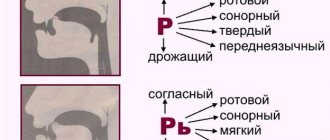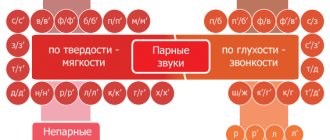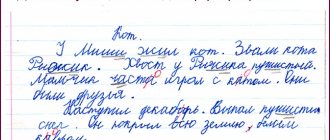Article:
Alalia is the absence or underdevelopment of speech due to organic damage to the speech areas of the cerebral cortex in the prenatal or early period of a child’s development
Causes:
- inflammatory lesions of the brain
- traumatic brain injuries
- cerebral hemorrhages as a result of difficult or rapid labor
- metabolic disorders during the period of intrauterine and early development
- consequences of severe rickets and respiratory system diseases
Happens:
- delayed maturation of nerve cells in certain areas of the brain (neuroblast stage) - in both hemispheres of the brain - bilateral damage.
May be:
- congenital underdevelopment
- early acquired underdevelopment (in the pre-speech period)
Motor alalia is a systemic underdevelopment of expressive speech of a central organic nature, caused by the immaturity of linguistic operations for generating speech utterances with the relative preservation of semantic and sensory operations. Motor alalia is a violation of the production of independent utterances with intact understanding of addressed speech.
Speech symptoms:
- phonetic disorders (sound pronunciation)
- underdevelopment of phonemic hearing
- agrammatisms in speech
- violations of word and phrase structure
- vocabulary is severely impoverished
- no coherent speech
- communication motivation is unformed
- speech understanding is intact
Non-speech symptoms:
- general motor clumsiness and underdevelopment of fine motor skills
- impaired coordination of movements
- underdevelopment of mental functions (attention, memory, thinking)
- pathological personality traits (low performance, negativism)
- secondary mental retardation (concrete thinking, poverty of logical operations, decreased ability for symbolization, generalization, abstraction)
- violation of oral and dynamic praxis
- lack of gaming skills
- impulsiveness, chaotic activity
- instability of interests
There are three levels of speech underdevelopment:
- level: lack of common speech
- level: rudiments of common speech
- level: speech with elements of underdevelopment in the entire speech system.
Speech samples:
Level 1:
- amorphous root words (“tya bang” - the cup fell, “Deka mo” - the girl is washing) can only be understood in the appropriate situation when reinforced by gestures and facial expressions
- the child uses only situational speech
Level 2:
- simple phrasal speech (“Sec. Ipyat. Syabaka pisses off the goki” - Snow. Guys. The dog runs down the hill)
Level 3:
- speech includes extended agrammatic statements (“Babuti Kaev and Guti and Manenka Syanata” - grandmother has a cow and geese and little piglets)
- level:
Speech therapy technique for alalia
Corrective work for motor alalia is the gradual formation of speech.
There are 5 stages in correctional work.
Stage 1 - one-word sentence (with non-speaking children)
Target:
- cause imitative speech activity in the form of sound manifestations
- expand speech understanding
- classes are conducted individually, in a playful way
- avoid using the words “say”, “repeat”, because Children may respond to these words. negative reaction (“guess, answer”), non-verbal tasks predominate
- children must hear correct speech, without chanting syllables; repeated repetition of the same verbal material is necessary
Speech understanding:
- remembering the names of toys, body parts, clothes (show your nose, teddy bear, dress)
- understanding of phrases supported by visual action
- verbalization of everyday situations (washing, dressing, etc. “Let’s go wash. Let’s open the tap. No, in the other direction. Opened it? Take the soap. Got it? Lather your hands. Three fingers. Okay. Rinse off the soap with water. Now let’s wash your face”)
- understanding the questions WHO? WHAT? WHERE? TO WHOM? WHERE? – questions are asked in context: “Where did you get the books from?”, and not “Where from?”
- understanding the instructions (“Place the toys like this: cube, doll, car”; “Put the doll on the chair, put the car on the table”)
You cannot repeat amorphous root words after your child; it is only permissible to use generally accepted simplified forms: DOLL - LYALYA, not KOOKA
Development of independent speech:
- a situation is created that causes the need for speech (a beautiful doll at the speech therapist: “Give”) - activation of speech imitation
- naming loved ones (“mom, dad”)
- expression of requests: (here, go, give, there, here, more)
- expressing a state with interjections (ay, oh, shh! - through a game situation)
- onomatopoeia for animals (dog – aw-aw, cow – muu)
- calling animals (kiss-kiss, chick-chick), controlling animals (Noo!, Whoa! Shoot!)
- introduction of onomatopoeia into poetry: GUSE, GEESE - GA-GA-GA, etc.
- imitation of musical toys: pipe - doo-doo-doo, balalaika - la-la-la, drum - boom-boom-boom
- imitation of traffic noises: car - beep, plane - oo-oo, train - tu-oo-oo
- introduction of onomatopoeia into poetry: Look into the skies - the plane is there like a wasp: U-U-U
- when playing lotto, use the words GIVE, ON, HERE, TAKE
- formation of phrases LET ME DRINK I WANT TO DRINK
LET ME STILL WANT TO WALK
MOM, LET'S GO FOR A WALK
MOM LE'S GO, GO HOME, etc.
Stage 2 - first forms of words
(children had the opportunity to combine 2-4 amorphous words without grammatical connections in one phrase)
Speech understanding:
- distinguishing the number of objects (many, few, one)
- distinguishing the size of objects (large - small)
- taste discrimination (sweet – salty)
- spatial location (here - there, here - here)
- distinction of units and plural Number: HOUSE – HOME
- discrimination of the negative particle NOT: GO – DON’T GO (without an object), TAKE – DON’T TAKE, HIDE THE BALL – DON’T HIDE THE BALL (with an object)
- distinguishing to whom the command is addressed: VOVA, SIT - CHILDREN SIT, SIT - SIT (imperative form of the verb in singular and plural)
Development of independent speech:
- sound pronunciation - clarification of the articulation of vowels (except Y), consonants M, P, B, T, D; other sounds are approximate pronunciation
- naming familiar objects
- building up syllables towards the end of the word: MU - ... RU - ... PO -, LAP - + KA
Children's ability to reproduce words of different syllabic structures is associated with the ability to combine words into sentences: as soon as two amorphous roots appear, it becomes possible to reproduce a word of two syllables by imitation.
- two-word sentence with the words “ THIS, HERE, HERE, THERE, HERE + creatures .”: HERE IS THE BUNNY THERE IS THE STICK HERE THE CAT IS THE CAR
- use of the imperative mood of the verb: commands to dolls - GO, SIT, RUN, CATCH, WASH
- use of the phrase “ appeal + imperative verb ”: KATYA, GO! SIT UP, MISHA
- the use of the phrase “appeal + imperative verb + Vin. Case of creatures.": KATYA, GIVE THE BALL (= I.p.), VOVA, PUT ON A FUR FUR (does not coincide with I.p.)
- the use of the phrase “verb in the indefinite.” Form + I WANT, I DON’T WANT, I NEED, I DON’T NEED, I CAN, I CAN’T” : I WANT TO SLEEP, I DON’T NEED TO WRITE, I CAN EAT, GO
Exercise: “ Who will do what ?” Dolls in various costumes (apron, pajamas... Who should go to bed? Katya doll, go to bed
The child must learn: the place of stress in memorized words, reproduce the rhythmic-intonation structure of 2-syllable words.
Stage 3 - two-part offer
(For children whose sentence size is 2-3 words)
Speech understanding:
- Distinguishing words that sound similar: MILA - SOAP, DONKEY - GOAT
- Distinguishing words that have similarities in an objective situation: CARRYING - LUCKY, DRAWING - WRITING, SEWING - KNITTING, WASHING - WASHING - WASHING
- distinguishing words with opposite meanings: PUT ON - TAKE OFF, STAND UP - SIT,
- distinguishing prefixes in passive participles: OPEN - CLOSED, OPEN - CLOSED
- understanding and distinguishing reflexive verbs: BATHING - BATHING, ROLLING - RIDING
- distinguishing the plural and singular verbs SLEEP - SLEEP, FLY - FLY
- distinguishing the gender of past tense verbs: ZHENYA FALLED – ZHENYA FALLED
- distinction between object and subject of action: VOVA, CATCH NINA. Who's running away?
- understanding the relationships between the characters: THE HARE RUNS AWAY FROM THE WOLF. – THE WOLF IS RUNNING AWAY FROM THE HARE. Where is the mistake?
- Spatial relations of objects: prepositions ON, IN, UNDER, ABOUT, FROM, FOR and their differentiation: IN-ON, UNDER-FROM, FROM-FROM, ABOUT-FOR
- Generalization of objects according to their purpose: WHAT DO YOU NEED TO DRAW?
- Distinction between units and many more numbers of nouns Suggestion case: RIDING A BICYCLE – RIDING A BICYCLE, SITTING ON A CHAIR – SIT ON CHAIRS
- Understanding adjectives with opposite meanings: NARROW - WIDE, LONG - SHORT, LOW - HIGH
- distinguishing spatial adverbs: BELOW, ABOVE, FAR, CLOSE, FORWARD, BACK
Independent speech:
- composing a sentence “beings. + verb + direct object”: A GIRL DRINKS JUICE, MOM MAKES SOUP
- composing a sentence “beings. + verb + object, not a match. in Vin Pad. with Him. " : MOM IS READING A BOOK
- the answer to the question “What does it do?” (selection of names of actions to the name of the object) MOTHER READS, LISTENS, SPEAKS...
- matching the names of objects to the names of actions: GOING...MOM, DAD, GIRL, AUNT, BROTHER...SITTING...CAT, BIRD...
- using the reflexive form of verbs: WASHES, COWS, SMILES
- memorization of couplets and quatrains with the completion of words: RAIN, RAIN, Drip-drip-drip, WET PATHS. WE CAN'T GO FOR A WALK...
- formation of the syllabic structure of a word: clapping of syllables in words a) from two identical syllables: DAD, MOM; b) from three open syllables: MACHINE
- formation of sound pronunciation - development of auditory perception: isolating words from the stream: HAT, CAT , NOSE, TOOTH, CAT , MOUTH, CAT ...; distinguishing words that sound similar in sound: FISHING ROOM—DUCK, expanding the volume of auditory memory (2-3 step instructions, 3-4 pictures)
Stage 4 - multi-word sentences
Target:
- teach how to build sentences of 3-5 words
- teach the simplest inflection of nouns and verbs
- develop coherent speech skills
Speech understanding:
- understanding case endings of nouns
- understanding adjectives and adverbs
Independent speech:
- consolidation of structures from the previous stage
- composing a sentence “beings. + verb. + 2 nouns in Vin and Dat cases”: KATYA READS OLE’S BOOK; MOM GIVES CANDY TO DAUGHTER
- composing a sentence “beings. + verb + 2 entities in Vin and TV cases): MOTHER CUTS THE BREAD WITH A KNIFE; DADDY CHOPS WOOD WITH AN AX
- composing a sentence using the construction “noun + verb + adverb” TANYA SINGS LOUD
- composing a construction with the preposition U: THE COW HAS HORNS; THE GIRL HAS A BOOK
- making a construction with the preposition B: PUT THE TOYS IN THE CLOSET, THE TOYS ARE IN THE CLOSET Game “What’s in your pocket?”
- composing a construction with the preposition ON: THE FLOWER IS STANDING ON THE TABLE; MISHA IS SLEDGING
- composing a construction with the preposition C: VOVA IS WALKING THE DOG
- composing a construction with the preposition K: THE DOG RUN TO VOVA
- composing constructions with the preposition UNDER: UNDER THE TABLE - UNDER THE TABLE
- composing the sentence “noun + verb + infinitive +1-2 exists in indirect cases” VOVA WANTS TO PLAY BALL WITH TANYA
- formation of the plural of nouns: CHAIR – CHAIRS, LEAF – LEAVES
- formation of the diminutive form of nouns: CUCUMBER - CUCUMBER
- formation of the negative form of the verb: I WILL GO FOR A WALK – I WILL NOT GO FOR A WALK (“naughty children”)
- comparison of verb forms: LIE – LIES – LIE, MY – WASHES – MY
- infinitive formation BOY DIGGING SAND AND WE WILL DIGGING
- syllable structure of the word: pronunciation of combinations - MNA, MNO, ME...
- production of sounds
- memorizing poetry (couplets and quatrains)
- learning stories: THE COCKER IS SINGING. CALLING THE HEN AND CHICKENS. THE COCKER FOUND THE GRAINS. I DID NOT EAT IT MYSELF, I GAVE IT TO THE CHICKENS. Or HERE IS OUR KITCHEN. ON THE STOVE IS A KETTLE - THE CHIEF OF ALL THE CUTLENS. THE WATER IS BOILING IN IT. LET'S DRINK TEA
Stage 5 - expansion of the scope of the proposal, complex sentence
Target:
- teach children to build complex sentences
- continue working on inflection
- teach to agree pronouns and adjectives with nouns
(for children who speak phrasal speech with manifestations of agrammatism)
Independent speech:
- formation of phrases “adverb MUCH + adjective + noun in Genus pad ”: MANY MULTI-COLORED BALLS
- agreement of pronouns with nouns: MY BALL – MY DOLL – MY BUCKET
- agreement of adjectives with nouns: BLUE RIVER - BLUE LAKE - BLUE STREAM
- distinguishing prefixes in verbs: LEAVED - DRIVED - DRIVED IN - MOVED - GOED - LEAVED
- drawing up a construction with the union A: SNOW IS WHITE AND COAL IS BLACK
- composing sentences with homogeneous subjects SQUIRREL, HARE, BEAR, ELK LIVE IN THE FOREST
- composing sentences with homogeneous predicates: CHILDREN AT SCHOOL READ, WRITE, COUNT, DRAW
- composing sentences with homogeneous definitions: THE CARROTS GROWED BIG, TASTY, ORANGE, JUICY, SWEET
- composing sentences with homogeneous additions: MASHA DRAWED A HORSE, A CAT, A GOAT, A PYRAMID
- composing sentences with homogeneous circumstances SNOW LIES ON THE ROOFS, ON THE GROUND, ON THE TREES, ON THE FENCE
- agreement of pronouns with the preposition U: I HAVE, HIM, THEM
- composing sentences with the conjunction A : SASHA IS DRAWING, AND MASHA IS READING A BOOK
- composing sentences with the words FIRST, THEN : FIRST YOU NEED TO WEAR A COAT, AND THEN MITTENS
- composing sentences with the conjunction OR : SASHA WANTS TO DRAW OR MOLD
- composing sentences with the conjunction BECAUSE : VOVA GOT SICK BECAUSE HE WET WET MY FEET
- making sentences with the conjunction SO: I TOOK THE BALL TO PLAY FOOTBALL game “What they said on the phone”
- formation of possessive pronouns: HARE TAIL, GRANDMOTHER'S GLASSES
- formation of relative adjectives: WOOD – WOODEN
- formation of adjectives from adverbs: FAST – FAST
- formation of degrees of comparison of adjectives: COLD – COLDER
- formation of cognate words: TEA - KETTLE - TEA PARTY - TEA - TEA PARTY
- formation of nouns from nouns: SALT – SALTS, PEPPER – PEPPER SHELL
- selection of polysemantic words: CHANTERELLES, BRAID, KEY
- selection of antonyms - nouns, verbs, adjectives: DAY - NIGHT, DAY - NIGHT, RISE - SIT DOWN
- distinguishing words with shades of meaning - GOING - MARCHING
- distinguishing words with similar meanings: ROVET - BREAKS
- replacing verb forms in the retelling: 1st person singular and plural to 3rd person
- formation of future tense verbs: WRITE - WILL WRITE - WILL WRITE
- formation of degrees of comparison from adverbs: FAST - FASTER, TASTY - TASTIER
Sensory alalia
Sensory alalia is a violation of speech understanding due to a malfunction of the auditory speech analyzer, which occurs when the temporal lobe of the dominant hemisphere
Manifestations:
- the child hears but does not understand spoken speech, physical hearing is preserved
- when examining hearing using equipment, auditory instability is detected (the same signals are sometimes perceived, sometimes not) - 8-10 audiograms are taken to make a final diagnosis
- the connection between the word and the object (action) is not formed - closing acupopathy
- hyperacusis - increased sensitivity to sounds that are indifferent to others (rustling of leaves, matches in a box, paper, creaking, dripping of water) Healthy people react to them during periods of fatigue and extreme irritation. Alaliks have anxiety, crying, turning their heads, pointing at their ears - super irritants
Psychophysical and speech features in sensory alalia - from complete misunderstanding of speech to understanding of individual everyday words and sentences:
- The situation plays a big role in understanding speech (they understand not individual words, but a phrase in a situation with a certain order of words in a sentence
- deterioration of understanding when the speaker's speech rate changes
- improved understanding with repeated slow repetition
- difficulties in turning on, switching and distributing auditory attention (do not immediately respond to speech, slowness of auditory perception)
- improved understanding after speaking (reinforced by one’s own kinesia)
- improved understanding if alalik looks at the speaker
- improved understanding when communicating with mother
Speech with sensory alalia:
- due to a lack of understanding of the speech of others, impossibility or gross distortion of one’s own speech
- motor restlessness, behavioral difficulties
- children use little gestures and facial expressions
- react to intonation, not understanding the meaning
- the game is accompanied by modulated babble
- logorrhea - incoherent reproduction of all words known to the child
- echolalia - repetition of addressed speech
- when the first words appear:
o mistakes in accent
- replacements
- distortions of the structure of an unfixed nature (each time a different error)
- the child’s statements are not accurate in content and erroneous in form
In general, the speech of a child with sensory alalia can be characterized as INCREASED SPEECH ACTIVITY DUE TO DECREASED ATTENTION TO THE SPEECH OF OTHERS AND LACK OF CONTROL OVER OWN SPEECH.
Speech therapy technique for sensory alalia
Main directions of correction:
- conscious analysis of speech composition
- development of phonemic awareness
- understanding speech structures
The basic principle of correctional work:
- consistent and systematic impact on all aspects of the child’s speech activity + specific treatment that stimulates the maturation of cerebral cortex cells
- Strict organization of sound and speech regime (since disordered auditory load delays speech development)
- determine hours and days of rest
- limit unnecessary communication
- exclude the influence of sound devices: telephone, radio, TV
- gentle sound mode + situation of visual and auditory starvation (“dark room”) – to increase sensitivity to sounds
- attracting the child’s attention (get into his field of vision, turn him towards you, take his hand)
- awakening interest in the sounds of the surrounding world and speech sounds
- distinguishing noises, non-speech sounds (the clink of a spoon in a glass, the tapping of a pencil)
- development of directed attention and performance - inserts, cut-out pictures, sticks, mosaics - sorting, classification by color, shape, size, etc.)
- development of visual and motor imitation: “ladushki”, “magpie”
- development of the need for communication, motivation for communication
- distinguishing sounding toys and instruments (The child watches the speech therapist’s action, does the action himself, closes his eyes (by gesture), distinguishes the source of the sound)
Secret: when working, avoid clapping your hands, stomping on the floor, or knocking on the table, because... in these cases, it is not sound that is perceived, but vibration
- introduction into the noise range of a strong speech sound (a, p, y), which is associated with an object or phenomenon
- normalization of performance, behavior, activity (copying actions, obeying non-verbal instructions)
- development of conditional connections between a word and an object or its image: UUU - steam locomotive, RRR - dog, MUUU - cow
- syllable discrimination: AU-UA-AM; MA-PA-NA-TA
- word discrimination (using motor, visual and tactile reinforcement) - the child shows a picture and performs the movement
- distinguishing the nature of sound, sound source, its localization
- object-practical actions - not only repetition of a word, but the ability to perform an action with an object according to verbal instructions: DRINK MILK FROM A BOTTLE, BLOW ON THE MILK, POUR MILK
- understanding standard phrases (words are pronounced in a certain order with the same intonation and are of an everyday, everyday nature -
- when communicating with one person
- when communicating with different people
- in a certain situation
- based on facial expressions, gesture
- development of phonemic hearing
- formation of one’s own speech (do not repeat or memorize phrases, but put the child in a situation of mental tasks )
- developing an understanding of logical, grammatical and thematic groups of words:
- dishes, furniture
- hand washing, soap, towel, water, wash, wipe
- flying - flying
- concretization of concepts (color - red, blue..., taste - salty, sweet...)
- early literacy
Researchers have questioned the possibility of completely eliminating sensory alalia. The prognosis is uncertain. The result depends on
- states of auditory sensitivity
- time and nature of treatment
- correctional and educational influence
- child's age and intelligence
Progress of the lesson:
I.
Introductory part:
1. Organizational point:
Time for business, time for fun. Listen to my story. I’ll sit up straight, I won’t bend, I’ll get to work! Check, my friend, are you ready to start the lesson? 2. Announcement of the topic and purpose of the lesson:
The topic of our lesson is “Dishes”. Let's get acquainted with the dishes.
II. Main part:
1. Game “sly spoon”.
Place utensils in front of the child: a plate (faience), a spoon (metal), a cup (glass) - and name each item. Ask the child to show objects and ask: “What is this?”
We will play with a spoon, tap the spoon on the plate: And name the dishes. "This is a plate." Knock with spoon
Close your eyes, take a cup.
Guess why the spoon is knocking? The child closes his eyes and listens to sounds.
Shows the dishes that were knocked on. Trying to give names to the dishes. (Loka, taka, cha-chaka)
2. Game "What is this."
The speech therapist invites the child to examine and show, then name the dishes (as best he can, without paying attention to articulation)
Items: teapot, cup, spoon, knife, plate. “I will... drink from a cup.” (child repeats: pp-pi)
“I’ll... eat from the plate (yum).” “I will use a knife...?” (cut-rr eat)
3. Physical exercise.
“Get up, let’s rest!”
I take the cup in my hands,
And I bring it to my mouth,
I tilt my head (performs the movements behind the speech therapist, independently)
I drink the tea to the bottom.
Well done. Sit down.
4. Game “Assignment”.
The child is standing at the table. Speech therapist: “Take a cup.” “What did you take? "
- cup. (chaku)
- "What did you do?" (took and dropped)
So continue with each of the dishes.
III.
Final part.
- Activity assessment: You were active in class. Well done, keep trying.
- Summing up: What dishes did you learn today? (child answers).
- Homework: written in an individual notebook: (play with dishes, learn to name each type)
Summary of an individual speech therapy session with a 4-year-old child.
Topic: "Wild Animals".
Purpose: to cause onomatopoeia;
Tasks:
- develop auditory attention,
- further development of the thoraco-abdominal type of breathing,
- activate vocabulary on the topic,
- develop fine motor skills and constructive praxis.
Equipment: toys or pictures with wild animals, cut-out pictures on the topic.
Causes of alalia in children
The occurrence of these disorders of the speech centers of the brain is associated with problems in intrauterine development or the first years of a child’s life:
- Severe pregnancy, leading to fetal hypoxia and intrauterine infection.
- Difficult childbirth - application of forceps, long anhydrous period, asphyxia, etc.
- Infectious diseases of a child in the first years - head injuries, diseases affecting the brain (encephalitis, meningitis).
Experts also attribute a hereditary factor to the reasons for the development of alalia. If there have been cases of speech disorders in the family, you should pay attention to this.
Prognosis for recovery
Most often, correctional work brings good results. The prognosis for recovery from motor alalia is favorable if rehabilitation is started early. Over the course of a year of work, the child learns to speak correctly and as speech develops, the intellectual lag, if it has developed, gradually disappears. A less favorable prognosis is for sensory alalia , which requires longer-term correction, and sensorimotor alalia is the most severe speech defect and complete restoration of speech is problematic.
The result of treatment in the latter forms depends on several factors: the presence of psychosomatic disorders and the degree of damage to the speech center (brain). With this pathology, disability issues are resolved at the age of 5 years. Alalia itself, as such, is not the basis for determining disability. Disability is established in the presence of persistent mental disorders that cannot be corrected. For example, even mild mental retardation is an indication for determining disability. With severe motor alalia and mental retardation, disability is even more indicated. All these issues must be resolved by a psychiatrist.
Motor alalia
In this case, the part of the child’s brain responsible for speech production is damaged. If the articulatory apparatus is intact, children cannot speak correctly.
This type is characterized by the following symptoms:
- Complete lack of speech. The child expresses himself using babble, gestures and facial expressions. Occurs with severe disruption of brain structures.
- If speech is present, it is characterized by incorrect sound pronunciation, agrammaticity, mixing and replacement of complex sounds, and a poor vocabulary.
- The child speaks using individual words or simple sentences of two or three words. In this case, nouns prevail and, as a rule, are used in the nominative case. The volume of the passive dictionary is much larger.
- Neurologically, there is poor development of fine and gross motor skills, poor coordination, and clumsiness.
- Higher mental activity also suffers - memory, attention, and the emotional-volitional sphere are reduced.
- A decrease in intelligence is only a consequence of a lag in speech development and, with proper correction, is restored.
Sensory alalia
This form of alalia is distinguished by underdevelopment of speech perception with excellent hearing. The child is not able to understand speech addressed to him; his own speech activity may even be increased.
Signs of sensory alalia:
- In severe forms, the spoken speech remains completely incomprehensible to the child. He himself can reproduce various sounds and a meaningless set of words.
- If the violation is not very pronounced, alaliks can understand the meaning of what was said in a certain context. However, outside of him, the meaning of what was said again eludes him.
- Children in this state are not critical of their own speech; they often use gestures or facial expressions to communicate.
- Psychologically, alalia is characterized by impulsiveness, increased fatigue in children, and attention disorders.
In its pure form, the sensory form of alalia occurs infrequently, in most cases it is combined with some manifestations of the motor one.







